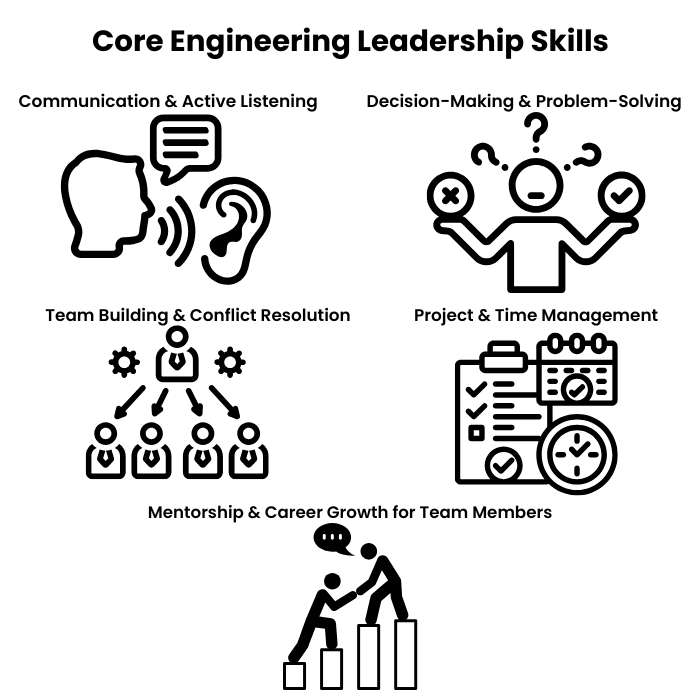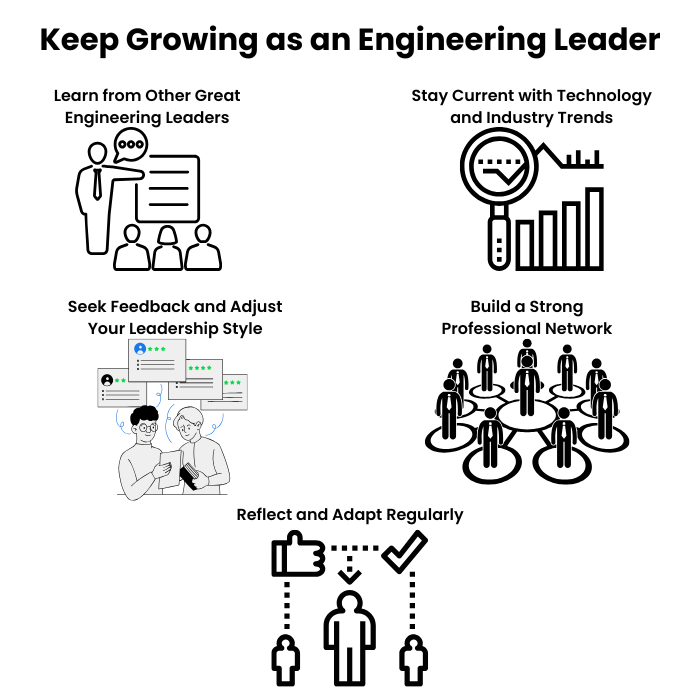Most engineers start by solving technical problems, but leading a team is a whole different challenge. It’s not just about writing great code or designing flawless systems—it’s about communication, decision-making, and guiding others.
A project can have top engineers, but without strong leadership, deadlines slip, conflicts arise, and motivation drops. Leadership holds everything together, ensuring teams stay focused and productive.
So how do you go from being a skilled engineer to an effective leader? That’s what this guide is all about. Whether you’re stepping into leadership or sharpening your skills, you’ll learn how to communicate better, make smarter decisions, and create an environment where engineers thrive. Let’s break it down.
What Makes a Great Engineering Leader?
You’ve probably worked with engineers who were brilliant at solving problems but struggled to lead a team. Maybe you’ve seen a technically gifted colleague get promoted, only to find themselves overwhelmed by the challenges of leadership. It happens all the time.
Engineering leadership isn’t about being the best coder or architect. It’s about guiding people, making smart decisions, and keeping projects moving. The best leaders balance technical knowledge with the ability to communicate, motivate, and strategize. Without that balance, even the most talented teams can struggle.
Technical vs. Leadership Skills – Finding the Right Balance
Early in your career, success is straightforward—solve problems, write great code, and deliver results. But leadership shifts the focus. Suddenly, it’s less about what you can do and more about what your team can accomplish together.
Think about it—have you ever worked under a manager who micromanaged every detail? They probably had strong technical skills but lacked trust in their team. On the other hand, some leaders stay too hands-off, leaving engineers without guidance. The best leaders find the middle ground. They understand the technical side but also know when to step back and let their team shine.
Transitioning from an individual contributor to a leader means changing how you think. Instead of jumping in to fix a bug, you help your team find the solution. Instead of focusing only on your work, you make sure the entire team is aligned and productive. It’s not an easy shift, but once you get it, everything changes.
Key Traits of Effective Engineering Leaders
So what sets strong engineering leaders apart? Here’s what matters:
- Vision and Strategic Thinking – Leaders don’t just focus on today’s tasks; they think ahead. They connect daily work to long-term goals and help their team see the bigger picture.
- Decision-Making Under Uncertainty – Sometimes, there’s no perfect answer. A good leader makes the best decision with the information available, knowing when to take calculated risks and when to hold back.
- Adaptability in a Fast-Changing Tech Environment – Tech moves fast, and leaders must keep up. Whether it’s shifting priorities, new tools, or unexpected challenges, adaptability keeps teams moving forward.
- Emotional Intelligence and Empathy – Engineering may be technical, but leadership is all about people. A leader who listens, understands challenges, and builds trust creates a team that’s motivated and engaged.
Great engineering leaders aren’t just technically skilled—they know how to bring out the best in their team. And that’s what makes all the difference.
Core Engineering Leadership Skills You Must Develop
You’ve probably worked with managers who barely communicated. Maybe they were brilliant engineers but left the team guessing when things went wrong. Projects stalled, confusion grew, and motivation dropped. Then, there were those who weren’t the most technical but kept everyone aligned, listened to concerns, and made sure the team functioned smoothly. The difference wasn’t intelligence—it was leadership.

Engineering leadership isn’t about knowing all the answers. It’s about guiding a team, making decisions, and creating an environment where engineers can do their best work. If you’re stepping into a leadership role, mastering these skills is essential.
Communication & Active Listening
Ever been in a meeting where a manager explained something, but by the end, no one knew what to do? That’s what happens when communication isn’t clear. As an engineering leader, your job is to ensure everyone understands the priorities, expectations, and goals without unnecessary complexity.
But communication isn’t just about talking—it’s about listening. Have you ever had an idea but hesitated to share it because you weren’t sure anyone would care? Many engineers feel the same way. Strong leaders encourage open discussions, ask the right questions, and make sure every voice is heard.
And then there’s feedback. Engineers thrive on problem-solving, but without feedback, they don’t know if they’re improving or missing the mark. A great leader gives feedback that’s direct, actionable, and focused on helping, not criticizing. If your team knows exactly what they’re doing well and where they need to improve, they’ll perform better.
Team Building & Conflict Resolution
You’ve seen it before—a group of skilled engineers who struggle to work together. Maybe one person needs detailed plans while another jumps in without structure. These differences create friction, but when managed well, they make teams stronger.
Great teams don’t just happen; they’re built. You need to recognize strengths, set clear expectations, and ensure everyone knows how their work contributes to the bigger picture. If an engineer feels valued and supported, they’ll deliver their best work.
And what about conflict? Disagreements happen in every team. The worst thing you can do is ignore them, hoping they’ll go away. Good leaders step in early, identify the root cause, and help team members find common ground. When handled well, conflict leads to better ideas and stronger teams instead of frustration and tension.
Decision-Making & Problem-Solving
Some decisions are easy—but others come with risks and uncertainty. Maybe a project is behind schedule, and you have to choose between cutting features or pushing the deadline. Or maybe you’re deciding between two competing technical solutions, each with its pros and cons. How do you choose?
Strong leaders don’t freeze when faced with tough decisions. They assess the facts, weigh the risks, and move forward with confidence. Sometimes, the right choice is backed by data; other times, it comes down to experience. The key is knowing when to trust the numbers and when to trust your instincts.
But decisions shouldn’t be made in isolation. If you’ve ever worked for a manager who made choices without consulting the team, you know how frustrating it can be. The best leaders involve their engineers in the process, ensuring everyone feels heard and invested in the outcome.
Project & Time Management
Have you ever been on a team where everything felt urgent, and yet nothing seemed to get done? Without clear priorities, projects can quickly spiral into chaos.
As a leader, your job is to make sure your team focuses on what truly matters. That means setting priorities, spotting bottlenecks, and ensuring engineers aren’t wasting time on low-impact work.
Deadlines are another challenge. Engineers love perfecting their work, but at some point, you have to ship. The best leaders know when something is “good enough” to launch and when it needs more refinement. Managing that balance is what keeps projects moving forward without sacrificing quality.
Mentorship & Career Growth for Team Members
Think back to your early career. Was there someone who gave you advice, pointed you to a great resource, or pushed you toward a new opportunity? A single conversation can change someone’s path.
As a leader, you have the chance to do that for your team. Engineers want to grow, whether that means deepening their technical skills, expanding into leadership, or just tackling more challenging projects. Your role is to help them find the right direction and give them the tools to get there.
Not every engineer wants to be a manager, and that’s okay. Some prefer to specialize, while others want broader experience. Great leaders understand that career growth isn’t one-size-fits-all. If you actively support your team’s development, you’ll build loyalty, increase engagement, and create a team that performs at its highest level.
Leadership isn’t about controlling every detail—it’s about enabling your team to succeed. When you communicate, build strong teams, make smart decisions, and support career growth, you create an environment where engineers do their best work. And that’s what engineering leadership is all about.
Overcoming Challenges as an Engineering Leader
Engineering leadership comes with constant challenges—some technical, others people-related. If you don’t address them early, they can slow progress, hurt morale, and create unnecessary roadblocks. Here are five key challenges and how to handle them effectively.
Managing Remote or Distributed Teams
Remote work brings flexibility but also miscommunication, time zone delays, and reduced team bonding. Without structure, messages get lost, and decisions take longer. Keep communication simple—set clear response times, use async updates wisely, and avoid unnecessary meetings. Regular check-ins and open discussions help remote teams stay connected and productive.
Balancing Technical and Business Priorities
Executives want speed, engineers want stability. If priorities aren’t aligned, deadlines become unrealistic, and shortcuts lead to technical debt. Strong leaders bridge the gap by translating technical needs into business value. Set clear expectations, communicate trade-offs, and ensure both sides understand the long-term impact of their choices.
Handling Team Conflicts and Different Work Styles
Every team has different personalities—some prefer detailed planning, others move fast and iterate. Without balance, friction builds. As a leader, your job is to recognize these differences and create a structure that works for everyone. Encourage open communication, set clear expectations, and step in early before small disagreements turn into bigger problems.
Making Tough Decisions with Limited Information
Engineering leaders often face high-stakes decisions without all the data. Waiting too long can stall progress, but rushing leads to mistakes. The best approach? Gather the facts available, involve key team members for input, and make a call based on logic and experience. Not every decision will be perfect, but decisive action beats hesitation.
Leading Through Change and Uncertainty
New technologies, shifting priorities, and unexpected challenges are part of engineering. Resistance to change slows innovation, but forcing it without explanation causes pushback. Guide your team through transitions by explaining the “why,” addressing concerns, and involving them in the process. When people feel heard and understand the impact, they adapt faster.
Leadership isn’t about avoiding challenges—it’s about handling them the right way. Stay clear, be adaptable, and keep moving forward.
How Can Engineering Leadership Development Enhance the Skills Needed for Leading High-Performing Technical Teams?
Engineering leadership skills training empowers managers to effectively guide technical teams. By focusing on communication, teamwork, and problem-solving, this specialized training enhances leaders’ ability to inspire innovation and drive results. As leaders develop these critical skills, their teams become more cohesive and productive, ultimately leading to superior project outcomes.
How to Continuously Improve as an Engineering Leader

Leadership isn’t something you master once—it’s a skill that grows with experience. The best engineering leaders don’t settle; they keep learning, adapting, and refining their approach. If you want to stay effective, here are five ways to keep improving.
1. Learn from Other Great Engineering Leaders
You don’t have to figure everything out alone. Some of the best leadership lessons come from those who’ve been there before. Read books, listen to podcasts, and follow experienced engineering leaders who share real-world insights. Learning from their successes (and mistakes) helps you avoid common pitfalls.
2. Seek Feedback and Adjust Your Leadership Style
If you’re not asking for feedback, you’re leading in the dark. Regularly check in with your team—what’s working, what’s not, and where you can improve. Honest feedback helps you refine your approach, and small adjustments can make a big difference in how your team responds to your leadership.
3. Stay Current with Technology and Industry Trends
Good engineering leaders understand both leadership and technology. If you fall behind on new tools, frameworks, or industry shifts, it becomes harder to make informed decisions. Stay curious, experiment with new technologies, and engage in discussions with peers to keep your technical knowledge sharp.
4. Build a Strong Professional Network
Surround yourself with other leaders who push you to grow. Join engineering leadership groups, attend industry events, and connect with people facing similar challenges. Exchanging ideas and learning from others’ experiences can help you find solutions to problems faster.
5. Reflect and Adapt Regularly
Great leaders take time to assess their progress. What leadership challenges have you faced recently? What could you have done differently? Reflection helps you spot patterns, improve decision-making, and adjust your leadership style to fit your team’s needs.
Leadership isn’t about being perfect—it’s about improving every day. Stay open to learning, listen to your team, and keep pushing yourself forward. That’s how great leaders are made.
Conclusion: Becoming a Leader Engineers Trust and Follow
Engineering leadership isn’t about being the smartest person in the room—it’s about making those around you better. The best leaders don’t just manage tasks; they shape teams, remove obstacles, and create an environment where engineers can do their best work.
Every interaction, decision, and challenge is a chance to grow. Leadership isn’t about perfection—it’s about progress. The more you refine your ability to communicate, guide, and adapt, the more effective you become.
Start by focusing on one area—maybe it’s improving how you handle conflicts, making clearer decisions, or simply listening more. Small changes stack up over time, shaping you into the kind of leader your team respects and trusts.
Your leadership journey never really ends—it evolves. Stay curious, stay engaged, and keep raising the bar for yourself and your team. That’s how you go from managing engineers to truly leading them.




